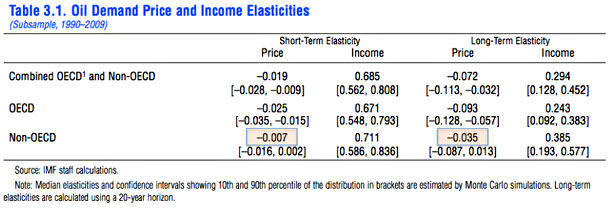“Price elasticity” is a measure of how people react to rising prices. A high number means they cut back sharply when prices rise. A low number means they just suck it up and keep buying.
So what’s the elasticity of oil prices? This is important, because it tells us, for example, how people are likely to react to higher taxes on gasoline. Will they use less and find other ways to get around? Or is it damn the torpedoes, keep burning the stuff, and figure out other places to cut back?
Stuart Staniford draws our attention to the latest estimates from the IMF, and as he says, they’re pretty eye popping. Here’s the table:

Take a look at the bottom row. “Non-OECD” means poor countries, and the IMF figures that short-term price elasticity in poor countries is -0.007, which means that a 1% increase in price leads to only a 0.007% decrease in consumption. Put another way, even a 50% increase in price leads to only a negligible 0.35% decrease in consumption1. Long-term elasticity is higher, but even here a 50% price hike would lead to only a 1.8% decrease in consumption.
The rich world is modestly more sensitive. In the short term, a 50% price increase produces a 1.2% decrease in consumption. In the long term, it produces a 4.7% decrease.
Part of the reason for these tiny effects is that income elasticity is quite large. That is, when income goes up, oil demand also goes up. In the short term, a 1% income increase in the poor world produces a 0.7% increase in oil demand. So as long as incomes are going up in the developing world (and they are), the effect of higher incomes swamps the effect of higher oil prices.
If these numbers are right, they’re pretty stunning. Even in the rich world, it apparently takes massive price increases to significantly reduce the demand for oil, even over a 20-year horizon. In the developing world, forget it. As long as incomes are going up, demand will go up. Urk.
1Actually, elasticity isn’t necessarily linear, so a 50% increase might have a bigger effect than 50 times a 1% increase. However, it’s probably not wildly non-linear at these levels, so the response to a 50% price increase is still likely to be quite small.













